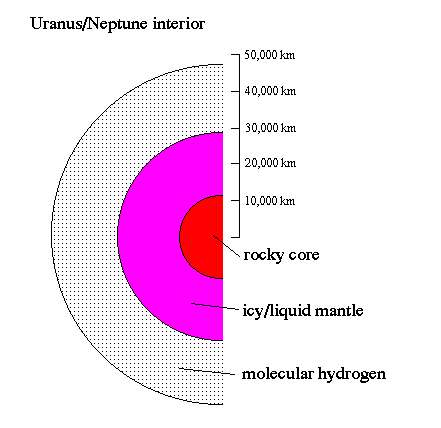Interiors of the Uranus and Neptune
Uranus and Neptune are similar to Jupiter and Saturn in that they have
large rocky cores and are primarily hydrogen and helium. However, they are
not the same in all respects. Their
outer layers are
hydrogen molecules H2, their middle layers are slushy material (
liquid water, methane,
and ammonia),
and their inner regions are composed of rocky
type material (the seed from the planet formation process). Because of their
lower masses compared to Jupiter and Saturn, the pressures in their interiors
does not get as large and metallic liquid hydrogen does not form.

A comparison of the interiors of Jupiter and Saturn to those of Uranus and Neptune
is shown below.

Again, how do we determine these general properties?
- density ---> made of primarily light stuff ---> hydrogen and helium
- seismology ---> no
- magnetic fields ---> yes ---> molten, conducting layer is needed--the ionized ammonia
in the mantle forms a nice conductor for this purpose
- nonspherical shapes (flattening due to rapid rotation) ---> interior structure
An interesting sidelight is that again Neptune radiates more energy than
it receives from the Sun, roughly 2.7 times as much energy. Interestingly, however,
Uranus does not exhibit this behavior. It is not clear why two such similar
planets do not behave the same.




